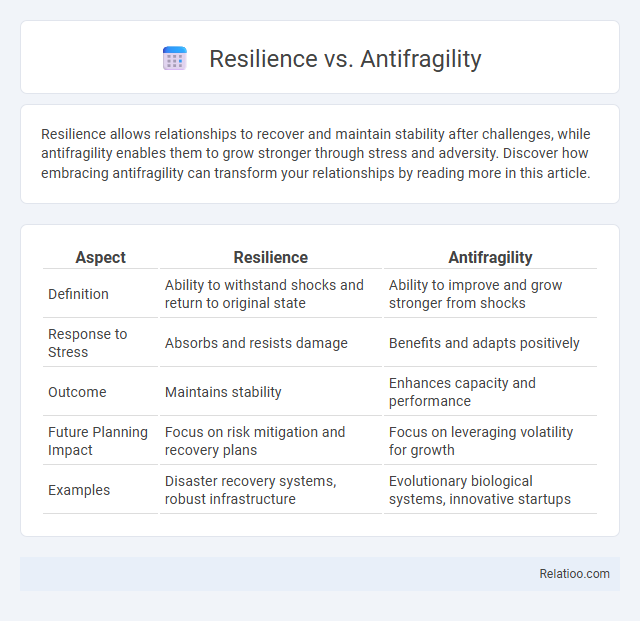Resilience allows relationships to recover and maintain stability after challenges, while antifragility enables them to grow stronger through stress and adversity. Discover how embracing antifragility can transform your relationships by reading more in this article.
Table of Comparison
| Aspect | Resilience | Antifragility |
|---|---|---|
| Definition | Ability to withstand shocks and return to original state | Ability to improve and grow stronger from shocks |
| Response to Stress | Absorbs and resists damage | Benefits and adapts positively |
| Outcome | Maintains stability | Enhances capacity and performance |
| Future Planning Impact | Focus on risk mitigation and recovery plans | Focus on leveraging volatility for growth |
| Examples | Disaster recovery systems, robust infrastructure | Evolutionary biological systems, innovative startups |
Introduction to Resilience and Antifragility
Resilience refers to the ability to withstand and recover quickly from challenges or disruptions, maintaining stability and function under stress. Antifragility goes beyond resilience by thriving and growing stronger when exposed to shocks, volatility, or uncertainty. Understanding these concepts helps you develop strategies that not only protect your systems but also enhance their capacity to improve and adapt through adversity.
Defining Resilience: Bouncing Back from Adversity
Resilience is the capacity to recover quickly from difficulties, enabling individuals or systems to bounce back after adversity without significant loss of function. Unlike antifragility, which implies growth or improvement through stress, resilience focuses on maintaining stability and returning to a baseline state. Your ability to cultivate resilience is essential for enduring challenges and regaining strength in the face of setbacks.
Understanding Antifragility: Thriving Amidst Chaos
Antifragility represents a system's ability to grow stronger when exposed to stressors, shocks, or chaos, unlike resilience which only aims to recover or withstand disturbances. Your capacity to harness antifragility means not just surviving but thriving amidst disorder by adapting and improving through challenges. Understanding this concept enables you to transform volatility from a threat into a powerful driver of growth and innovation.
Key Differences Between Resilience and Antifragility
Resilience refers to the ability of a system or individual to withstand shocks and return to its original state, maintaining stability despite stress or disruptions. Antifragility goes beyond resilience by improving and growing stronger when exposed to volatility, randomness, and challenges, rather than merely recovering. Key differences include resilience as a form of resistance and recovery, whereas antifragility involves beneficial adaptation and enhancement through adversity.
Real-World Examples of Resilient Systems
Resilient systems, such as power grids designed to withstand natural disasters, quickly recover from disruptions by maintaining core functions under stress. Antifragile systems, like certain financial markets or biological ecosystems, improve and adapt when exposed to volatility or shocks, benefiting from disorder. Your understanding of these concepts is enhanced by recognizing that resilience focuses on recovery, while antifragility emphasizes growth through challenges.
Case Studies Illustrating Antifragile Systems
Case studies of antifragile systems reveal entities that improve through stressors and uncertainty, unlike resilient systems which merely resist shocks and return to the original state. For example, financial markets leveraging volatility through diversified portfolios demonstrate antifragility by benefiting from market fluctuations rather than just enduring them. Similarly, biological ecosystems that evolve adaptability traits when exposed to environmental pressures highlight antifragility by gaining strength, whereas purely resilient systems simply survive disruptions without growth.
Benefits of Cultivating Resilience
Cultivating resilience enhances your ability to adapt and recover swiftly from adversity, leading to improved mental health and sustained performance under pressure. Unlike antifragility, which thrives on stress to grow stronger, resilience stabilizes you, providing consistent emotional strength and reducing vulnerability to burnout. Building resilience promotes long-term well-being and equips you with effective coping strategies essential for navigating life's challenges.
Advantages of Embracing Antifragility
Embracing antifragility offers significant advantages over mere resilience by enabling systems and individuals to grow stronger through stress and adversity rather than just withstand or recover from shocks. Antifragile entities not only survive disruptions but improve their performance by leveraging volatility, uncertainty, and chaos as catalysts for development. This proactive adaptation enhances long-term sustainability, innovation, and competitive advantage in dynamic environments.
Building Resilience vs Fostering Antifragility: Strategies and Approaches
Building resilience involves developing the capacity to recover from setbacks by strengthening mental toughness, adaptive skills, and emotional regulation techniques. Fostering antifragility requires embracing challenges as opportunities for growth through proactive experimentation, stress inoculation, and leveraging variability to enhance capability beyond baseline recovery. To enhance Your performance, integrating stress management with innovative problem-solving strategies transforms mere resilience into antifragility, ensuring continuous improvement and robustness against future volatility.
Choosing the Right Approach: When to Be Resilient or Antifragile
Resilience involves maintaining stability and recovering quickly from adversity, while antifragility goes beyond by thriving and growing stronger through stress and challenges. Choosing the right approach depends on context: resilience is optimal for predictable environments requiring durability, whereas antifragility suits dynamic, uncertain systems where adaptation and improvement are vital. Understanding these distinctions enables individuals and organizations to tailor strategies effectively, promoting sustainable growth in varying conditions.

Infographic: Resilience vs Antifragility
 relatioo.com
relatioo.com